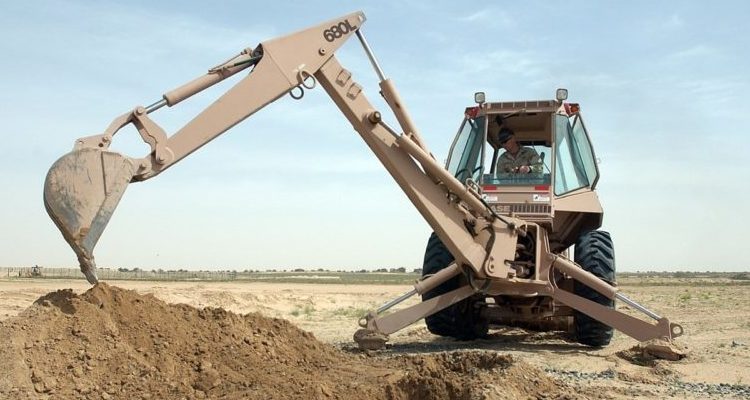
The most basic purpose of a backhoe is to perform digging. It is safe to say that a backhoe proves to be more than efficient for that task. Pair that with the backhoe’s material moving and lifting capabilities and combine it with various attachments for extra functions, and you have an excellent machine that is more than capable of performing multiple tasks on any job site. This article covers tips on transporting as well as operating your backhoe.
Sure, the productivity that a backhoe offers is great, however, making the most out of a backhoe does not mean in any way that you have to buy tons of attachments. Instead, you have to focus on some simple yet effective operational tips that will come in handy to provide you better results, more uptime, and even added safety while you are operating a backhoe.
Transporting and Operating a Backhoe
Whether you are a novice or a seasoned professional, following these helpful tips for operating and transporting a backhoe will equip you with the right knowledge and skills to get the most out of your backhoe.
Transporting
If you are looking to transport your backhoe from one destination to another, you might be thinking about your options. Truth be told, there are plenty of them – you can either transport the backhoe yourself or utilize a flatbed. In some cases, the backhoe seller takes care of transportation themselves. However, if your backhoe seller didn’t provide you that option, the ideal thing to do would be to acquire professional help for transporting oversized or heavy equipment. Mentioned below are some tips to consider before transporting a backhoe:
1. Get Professional Assistance
Acquiring the services of a transporting company is quite efficient. It ensures that your backhoe is being handled by someone who has the right machinery and license for transporting your backhoe in a safe and timely manner. It will minimize the planning and stress from your backhoe hauling while making sure that your backhoe reaches its destination in its original condition.
2. Getting Licensed
You must obtain a license if you plan to transport your backhoe by yourself. You will need a commercial driving license (CDL) for driving a flatbed. That being said, the type of CDL required also varies based on the truck’s weight and on the item you are hauling. Getting a license can sometimes be a tedious process, which is why many people end up choosing a professional backhoe hauling service.
3. Be Careful When Loading
Caution is essential when loading a backhoe. You must ensure the backhoe has been attached to a flatbed firmly. Then, you will need to remove the bucket pin and start lowering it. After this, you have to hold the backhoe down with ratchet straps or chains, making sure that it does not move.
Do not forget to check all of the regulations and rules of your state or province before you start loading. Once again, loading by yourself can be quite wearisome and dangerous. If you do not know what you are doing, the wise thing to do would be to get a professional hauling service’s help to get the job done.
Operating a Backhoe
First, ensure you have followed the basic steps to becoming a heavy equipment operator. Remember that there could be slight variation in some backhoes. However, with some basic knowledge, you will have a clearer grasp regarding how you should operate the standard controls in a backhoe.
Getting Acquainted With The Basic Controls
Left and Right Arm Control
The left-hand lever is in charge of controlling the boom. You have to draw the lever towards yourself to lift the boom in the air. To lower the boom to the ground, push the lever away from yourself. Similarly, you have to tug the left arm control lever right and left for swinging it sideways.
The right arm control operates the stick (rear arm), which is the portion attached to the lever’s bucket. Draw the lever in towards yourself for bringing the bucket and stick towards the cab. Thrust the lever away from yourself to move the bucket and stick from the cab. If you want to pull or curl the bucket in your direction, move the right-hand lever to the left. Move it to the right if you want to move the bucket in the opposite direction.
Stabilizing Controls
These controls are present in the center of the right and left arm controls. The stabilizer controls are smaller than the arm controls and, as the name suggests, control the backhoe’s stabilizer. The left lever controls the left stabilizer while the right lever controls the right stabilizer. You can move each stabilizer independently when operating the backhoe in rough terrain or otherwise bumpy conditions.
Boom Unlock
This mechanism makes sure that it keeps the boom arm in position. You can unlock the arm once you are ready to dig. A boom unlock, in most backhoes, is found in the form of a pedal located on the floor.
Throttle Control
The throttle control is a knob that adjusts an engine throttle’s Revolutions per Minute.
- Most backhoe attachments have different Revolutions per Minute
- Small jobs often need lesser RPMs
The Basics for Operating Backhoe Ignition
First of all, ascent the steps of your backhoe and grab hold of its entrance handle. Turn inside, fully entering the cab and shut its door once you are seated. Fasten your seatbelt, and once you do, give the backhoe’s ignition a slight turn (preferably a quarter). Depending on your model, you’ll want to keep your foot on the control once you notice a beep. Follow this up by releasing the parking brake. Once you do, rotate the ignition completely.
Digging with a Backhoe
First off, it is vital to park your backhoe somewhere with enough side and rear clearance. Ideally, angle the backhoe towards the right or left slightly to make sure you can see behind the boom and stick while you are digging. Start lowering the stabilizers until you notice suspended rear wheels. Remember to be in neutral to avoid tipping over. Lower down the front bucket until you see the backhoe’s front wheels becoming suspended. Grasp the left control and pull it towards yourself, making sure that the boom gets to maximum height. After that, keep your foot on the boom unlocking pedal while pulling the left control simultaneously.
Push the left arm control for pushing down the boom. Moving the boom and the stick simultaneously will provide maximum reach. Shift the right control towards the left for getting the bucket to curl towards you. Keep holding the lever on the left until you notice something solid hitting the backhoe. It indicates that the bucket is completely loaded. Pull the right arm for bringing up the boom. Shift the left arm by moving it on the right or left for swinging the full bucket and boom towards a dumping spot. Turn the right control on the right for dumping the bucket. Similarly, use the left control to get the boom back to the trench.
Backfilling
You may need to fill the hole again once you complete the trenching. Here is what you’ll need to do:
- First, shove the material in the hole again using your backhoe’s front loader bucket.
- Drive the backhoe over the hole you just filled, packing the materials tightly in the hole.
- Make the area smooth by driving your backhoe in reverse while positioning the front bucket downwards at an angle.
Stay Safe
If you know the basics, operating a backhoe can be simple. That being said, you must practice safety no matter how good of an operator you are. You can avoid fatalities and injuries by just being mindful of things like traveling too fast on irregular surfaces, checking fluid levels of your backhoe in advance, and making sure that you are aware of all utility lines before operating. You must also make sure that you keep your front bucket low if it is full. Keep it close to the ground while making sure that both the people and things in the surrounding area remain safe. Lowering the front bucket significantly minimizes the chances of tipping over while operating.
This article was written by a guest contributor for Gearflow.com, Chris Ward, who is a marketing manager at A1 Auto Transport.


That’s a good idea to make sure that you could see around the boom. I like the idea of making sure that I could see anything that it may hit, so I cm make sure that nothing gets damaged., I’ll make sure to do that if I decide to rent an excavator.
Thanks for pointing out that you want to make sure that the backhoe is attached property. It does seem like it would be a huge problem if the bucket came off while you were using it. Personally, I would want to make sure that any attachment I used was put on correctly. Putting it on wrong seems like it would be very dangerous.
You are right Emily! Safety is paramount on any job site and should always be prioritized. Make sure that you are also using the correct attachments to ensure your equipment works properly.
Hi, thank you for such a brilliant post. I have been reading some blogs that gives me more knowledge about the guide for transporting operating a backhoe . I must say this is one of the best among them. You have done a great research for I feel, thanks for sharing.
Thank you so much, glad you enjoyed it!
It’s a great source of knowledge; I think it will be helpful for lot of people who are looking for learning more about the guide to transporting operating a backhoe. Thank you very much for sharing this article.
Great article! Thank you for the information
It was interesting when you mentioned that using a backhoe can be simple if you know the basics. I would imagine that it would be important to know how to perform maintenance on a backhoe as well. Regular maintenance would be crucial for keeping the backhoe operating efficiently.
It was interesting to learn about how although every machine has some variation they should be trained to operate heavy equipment. I can understand how a company could really benefit from having the right machines. Having them operated by a professional could allow them to be more effective.